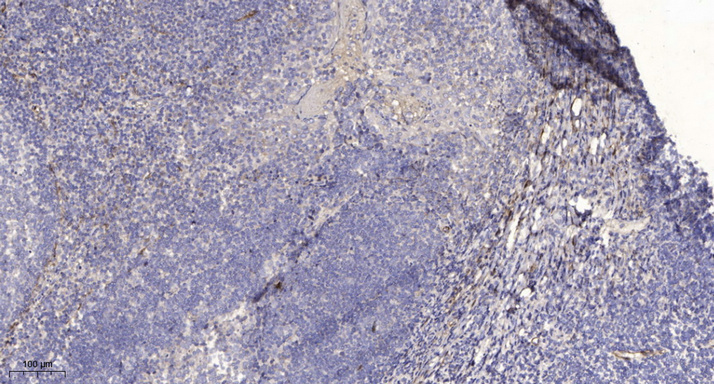PLUNC Polyclonal Antibody
- Catalog No.:YT3799
- Applications:IHC;IF;ELISA
- Reactivity:Human;Rat;Mouse;
- Target:
- PLUNC
- Gene Name:
- BPIFA1
- Protein Name:
- BPI fold-containing family A member 1
- Human Gene Id:
- 51297
- Human Swiss Prot No:
- Q9NP55
- Mouse Swiss Prot No:
- P97361
- Immunogen:
- Synthesized peptide derived from the Internal region of human PLUNC.
- Specificity:
- PLUNC Polyclonal Antibody detects endogenous levels of PLUNC protein.
- Formulation:
- Liquid in PBS containing 50% glycerol, 0.5% BSA and 0.02% sodium azide.
- Source:
- Polyclonal, Rabbit,IgG
- Dilution:
- IHC 1:100 - 1:300. ELISA: 1:40000.. IF 1:50-200
- Purification:
- The antibody was affinity-purified from rabbit antiserum by affinity-chromatography using epitope-specific immunogen.
- Concentration:
- 1 mg/ml
- Storage Stability:
- -15°C to -25°C/1 year(Do not lower than -25°C)
- Other Name:
- BPIFA1;LUNX;NASG;PLUNC;SPURT;BPI fold-containing family A member 1;Lung-specific protein X;Nasopharyngeal carcinoma-related protein;Palate lung and nasal epithelium clone protein;Secretory protein in upper respiratory tracts;Trach
- Molecular Weight(Da):
- 27kD
- Background:
- This gene is the human homolog of murine plunc, and like the mouse gene, is specifically expressed in the upper airways and nasopharyngeal regions. The encoded antimicrobial protein displays antibacterial activity against Gram-negative bacteria. It is thought to be involved in inflammatory responses to irritants in the upper airways and may also serve as a potential molecular marker for detection of micrometastasis in non-small-cell lung cancer. Multiple transcript variants resulting from alternative splicing in the 3' UTR have been detected, but the full-length nature of only three are known. [provided by RefSeq, Aug 2014],
- Function:
- function:May be involved in the airway inflammatory response after exposure to irritants. May be associated with tumor progression. May play a role in innate immune responses of the upper airways.,induction:By all-trans retinoic acid (ATRA).,miscellaneous:Binds lipopolysaccharides.,PTM:May be N-glycosylated.,similarity:Belongs to the BPI/LBP/Plunc superfamily. Plunc family.,subcellular location:Found in the nasal mucus (By similarity). Apical side of airway epithelial cells. Detected in nasal mucus.,tissue specificity:Lung, upper airways and nasopharyngeal regions, including trachea and nasal epithelium. Specifically expressed in the secretory ducts and submucosal glands of tracheobronchial tissues. Highest expression in the trachea and progressive decrease from proximal (bronchial) to distal (bronchiolar) airways. Also expressed in lung cancers and some other types of cancer.,
- Subcellular Location:
- Secreted . Apical side of airway epithelial cells. Detected in airway surface liquid, nasal mucus and sputum.
- Expression:
- Highly expressed in lung, upper airways and nasopharyngeal regions, including trachea and nasal epithelium (at protein level) (PubMed:11018263, PubMed:11251963, PubMed:12409287, PubMed:11425234, PubMed:26559477). Specifically expressed in the secretory ducts and submucosal glands of tracheobronchial tissues (at protein level) (PubMed:12409287, PubMed:11425234). Also expressed in the eye where it is detected in lacrimal gland, eyelid, conjunctiva and cornea (at protein level) (PubMed:26559477). Specifically localizes to epithelial cell layers in cornea, eyelid (basal epithelium) and conjunctiva (at protein level) (PubMed:26559477). Detected within acinar cells and ducts in the lacrimal and Meibomian glands (at protein level) (PubMed:26559477). In lung, shows highest expression in the trache
- June 19-2018
- WESTERN IMMUNOBLOTTING PROTOCOL
- June 19-2018
- IMMUNOHISTOCHEMISTRY-PARAFFIN PROTOCOL
- June 19-2018
- IMMUNOFLUORESCENCE PROTOCOL
- September 08-2020
- FLOW-CYTOMEYRT-PROTOCOL
- May 20-2022
- Cell-Based ELISA│解您多样本WB检测之困扰
- July 13-2018
- CELL-BASED-ELISA-PROTOCOL-FOR-ACETYL-PROTEIN
- July 13-2018
- CELL-BASED-ELISA-PROTOCOL-FOR-PHOSPHO-PROTEIN
- July 13-2018
- Antibody-FAQs
- Products Images

- Immunohistochemical analysis of paraffin-embedded human tonsil. 1, Antibody was diluted at 1:200(4° overnight). 2, Tris-EDTA,pH9.0 was used for antigen retrieval. 3,Secondary antibody was diluted at 1:200(room temperature, 30min).



